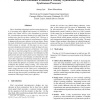Free Online Productivity Tools
i2Speak
i2Symbol
i2OCR
iTex2Img
iWeb2Print
iWeb2Shot
i2Type
iPdf2Split
iPdf2Merge
i2Bopomofo
i2Arabic
i2Style
i2Image
i2PDF
iLatex2Rtf
Sci2ools
ISCA
2002
IEEE
2002
IEEE
Power and Performance Evaluation of Globally Asynchronous Locally Synchronous Processors
Due to shrinking technologies and increasing design sizes, it is becoming more difficult and expensive to distribute a global clock signal with low skew throughout a processor die. Asynchronous processor designs do not suffer from this problem since they do not have a global clock. However, a paradigm shift from synchronous to asynchronous is unlikely to happen in the processor industry in the near future. Hence the study of Globally Asynchronous Locally Synchronous (or GALS) systems is relevant. In this paper we use a cycleaccurate simulation environment to study the impact of asynchrony in a superscalar processor architecture. Our results show that as expected, going from a synchronous to a GALS design causes a drop in performance, but elimination of the global clock does not lead to drastic power reductions. From a power perspective, GALS designs are inherently less efficient when compared to synchronous architectures. However, the flexibility offered by the independently contro...
GALS | Gals Designs | Global Clock | Hardware | ISCA 2002 |
| Added | 15 Jul 2010 |
| Updated | 15 Jul 2010 |
| Type | Conference |
| Year | 2002 |
| Where | ISCA |
| Authors | Anoop Iyer, Diana Marculescu |
Comments (0)

